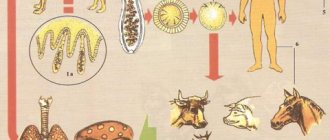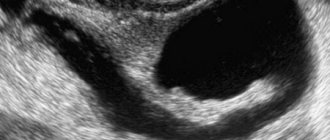Even a completely healthy woman sometimes experiences menstrual irregularities. Deviations occur especially often during puberty, as well as after the onset of menopause. Usually a woman knows by her feelings when ovulation occurs and feels the approach of menstruation. But sometimes the cycle proceeds atypically: menstruation comes later, there are no characteristic pains in the lower abdomen and chest. Most likely, in this case the cycle is anovulatory. You don't always have to worry and go to the doctor. If this is a pathology, then other symptoms of gynecological diseases appear.
BT schedule for anovular menstrual cycle
In the case of an anovular menstrual cycle, the basal temperature does not increase in the second phase of the cycle. Temperature changes range from +36.4C to +36.9C. This means that with this type of monthly cycle, pregnancy does not occur because the egg does not mature.
BT schedule for anovular menstrual cycle
To make sure that there is a problem with conception, a basal temperature chart should be drawn up for 2-3 subsequent menstrual cycles.
When to see a doctor
And only after confirming that pregnancy is not occurring, consult a doctor if:
- The graph shows decreasing basal temperature throughout the menstrual cycle (anovulatory cycle);
- The basal temperature chart shows an increase in temperature throughout the monthly cycle (Hyperprolactinemia);
- The graph displays a straight line, which indicates corpus luteum deficiency;
- When pregnancy occurs, basal temperature increases very quickly. If it slows down in the middle of the monthly cycle, then this indicates a problem with the woman’s hormonal system;
- Delayed menstruation without pregnancy;
- The monthly cycle lasts more than 35 days or less than 21 days.
When to see a doctor
Basal temperature chart during pregnancy
During pregnancy, the corpus luteum remains in the ovary for a long period. It produces progesterone, without which normal pregnancy is impossible. The hormone causes relaxation of the uterus, which is necessary to prevent miscarriage. Progesterone also promotes changes in the mammary glands and prevents the next ovulation in the ovaries. High basal temperature during pregnancy persists throughout all nine months. From the moment the placenta forms at week 16, progesterone begins to be synthesized in it, so the corpus luteum in the ovary is reduced. Photo (graph of basal temperature during pregnancy) If a woman measured her temperature during the cycle, she may suspect pregnancy if it does not decrease before menstruation. A graph of basal temperature during pregnancy helps to see that it consistently stays above 37 degrees. 7 days after ovulation, there may be a slight decrease in temperature due to implantation of the egg into the endometrium. If she begins to hesitate with a positive pregnancy test, then she should urgently go to the doctor. This may be a sign of an incipient miscarriage. Normally, a pregnant woman’s basal temperature should not decrease by more than 0.2 degrees.
Oscillations
Throughout the monthly cycle from one menstruation to the next, the basal temperature changes. These fluctuations are directly related to changes in the level of sex hormones in a woman. The temperature rises before the onset of menstruation, which is especially noticeable when measured in the morning. The basal temperature charting method is still considered one of the reliable methods for determining the ovulation of an egg.
Fluctuations in the schedule
How to measure basal temperature correctly?
- The first measurement should be taken immediately after waking up in the morning, without getting out of bed or having breakfast.
- The thermometer is inserted into the anus, vagina or mouth, under the tongue. You need to hold the thermometer for 5 minutes.
- You need to start measuring BBT first after your next menstruation.
- The measurement readings are entered into the chart immediately. All entries characterizing the woman’s condition (pulling pain in the lower abdomen, vaginal discharge, sexual intercourse and taking medications) are included in the temperature sheet.
Based on the BT chart, you can see fluctuations in the level of sex hormones and make sure that the egg has ovulated, which means pregnancy has occurred. One of the main advantages of basal temperature is that it provides the opportunity to evaluate the functioning of the ovaries throughout the menstrual cycle in the dynamics of development. The disadvantage of the method for women is that measuring basal temperature requires daily and careful manipulation of the thermometer and no less careful recording of the obtained data in the temperature sheet.
Basal temperature chart
This problem is one of those that comes unexpectedly and hits hard. Most often, a young girl does not know at all that she has an anovulatory cycle: she does not keep a basal temperature (BT) chart and does not do ovulation tests. And this is natural, because she is not going to get pregnant yet. Menstruation comes on time, nothing hurts or bothers me.
And so she decides to become a mother. But the second cycle comes, the third, the fourth... Several months pass of fruitless (in every sense of the word) attempts to have a child. A woman begins to “catch” ovulation using tests or a thermometer. And she finds out that in the second phase of the cycle her basal temperature is low. Often (though not always) this is an alarm bell that not everything is fine with women’s health.
What should the BT schedule be?
The monthly cycle of a healthy woman consists of two main phases - follicular and luteal. In the first phase, follicles—female reproductive cells—mature in the female ovaries. One follicle (less often several) matures faster than others. This is the so-called dominant follicle. Around the middle of the cycle, it bursts and a mature egg is released. The process of releasing an egg is called ovulation.
In place of the burst follicle, a corpus luteum is formed - this is a special gland that produces hormones (in particular, progesterone). The luteal phase of the cycle begins, during which the uterine mucosa becomes loose to accept the fertilized cell. If conception does not occur, menstruation begins approximately two weeks after ovulation.
To track ovulation, you can use special pharmacy tests. But they are quite expensive. Therefore, many people use the method of measuring basal temperature: throughout the entire cycle, they measure the temperature in the rectum. This should be done in the morning, immediately after waking up, without getting out of bed.
During the first phase of the cycle, the basal temperature is usually 36.0-36.7 degrees. Closer to the middle of the cycle, it may drop by a few tenths of a degree, and then, after ovulation, it rises sharply to 37 and above. A few days before menstruation, BT may drop to 36.5-36.9 degrees (although this does not always happen).
How is diagnostics carried out?
An accurate diagnosis cannot be established by external examination, so research is required. They are carried out by a gynecologist by examining the cervix and the uterus itself and palpating the ovaries in case of swelling. Samples are also collected for research by scraping from the uterine mucosa.
Blood for analysis is donated several times during the specified period of the cycle in order to find out the level of hormones in different phases of menstruation. An ultrasound examination and an ultrasound examination are prescribed, during which the thickness of the uterine epithelium and the development of the follicles are measured.
At different phases of the menstrual cycle, the temperature in the rectum is measured; when a mature cell matures and emerges, the temperature rises to 37 degrees.
What is anovulation
With hormonal disorders, ovulation may be absent. In an anovulatory cycle (a cycle without ovulation), the follicle does not mature, or it matures, but for some reason does not burst. Accordingly, there is no egg, and conception is impossible.
In this case, the cycle is not two-phase, but monophasic. The basal temperature in the second phase is low: it does not rise above 36.9. The basal temperature chart is anovulatory if BT throughout the cycle ranges from 36.2 to 36.9 and does not rise in the middle of the cycle. There are even situations when BT has fallen after expected ovulation, that is, it becomes lower than in the first phase. Most likely, this means that ovulation did not occur.
An example of an anovulatory BT schedule.
Basal temperature chart for insufficiency of the second phase of the cycle (luteal phase)
Insufficiency of the second phase of the cycle is understood as a condition in which there is a decrease in the amount of progesterone. Ovulation occurs during such cycles, that is, the basal temperature during conception rises slightly, but rarely exceeds 37 degrees. This situation arises due to the fact that the corpus luteum does not function fully. Photo (graph of basal temperature for corpus luteum deficiency) Such cycles are characterized by a gradual increase in temperature in the middle of the cycle (but it should be sharp). Its peak occurs shortly before menstruation, so there is no proper drop in temperature before menstruation. The graph also reveals a shortening of the duration of the second phase of the cycle. Progesterone is needed to prepare the endometrium for embryo implantation. Often, with this diagnosis, a woman does not become pregnant at all, or experiences early miscarriages. To identify the cause of the disease, it is necessary to examine the pituitary gland, adrenal glands and ovaries. Measuring basal temperature helps to identify abnormalities and take the necessary actions in terms of examination and treatment.
Diagnostics
It is important to know that measuring basal temperature is just an auxiliary, and not the main method for diagnosing anovulation. It's not particularly accurate. Some doctors consider it outdated and do not recommend it to their patients at all. The temperature in the rectum can be affected by many factors:
- Incorrect measurement. For example, you insert a thermometer after you went to the toilet and went back to bed. Or don't hold the thermometer long enough;
- Sex on the eve of measurement;
- Colds;
- Inflammatory diseases of the genitourinary system;
- Diseases of the thyroid gland, etc.
Measuring BT during one cycle does not mean anything at all! It is necessary to measure the temperature for at least three cycles in a row. And if in all three cycles the schedule is monophasic, the doctor will be able to draw some conclusions.
Remember: no doctor can make a diagnosis or prescribe treatment (for example, ovulation stimulation) based solely on a chart! A good doctor will perform a gynecological examination and prescribe ultrasound ovulation monitoring - these are several ultrasounds that monitor follicle growth and ovulation throughout the cycle. Moreover, it needs to be done not in one cycle, but in several.
In addition, the following examinations may be needed:
- Hormone tests (in each specific case the list will be different);
- Ovulation tests may be needed. They are more accurate than measuring BT, however, false positive and false negative results are also possible here;
- Ultrasound of the thyroid gland, TSH analysis when planning pregnancy;
- If the doctor suspects that the cause is a malfunction of the hypothalamic-pituitary system, an X-ray examination of the skull or an MRI may be prescribed;
- Diagnostic endometrial curettage and other studies.
How to cure an anovulatory cycle and get pregnant
If you are not ovulating, you should consult a doctor who, having found out the reason, will recommend appropriate treatment. This could be, among other things, treatment with hormones or contraceptives. Therapy usually lasts up to 6 months, however, it has many disadvantages, for example, it affects the condition of the kidneys or liver. Another form is psychological support - if, of course, the reason lies in a stressful state.
Stimulation and monitoring of ovulation
The main goal is to induce oocyte maturation and ovulation in patients with a violation of this process. Stimulation is carried out when there are no indications for the use of assisted reproduction methods (intrauterine insemination and in vitro fertilization).
To stimulate ovulation, the most commonly used is: Clomiphene citrate (Clostilbegit)
This is an effective, cheap and easy to use medicine (tablets). The main indications for treatment are:
- infertility due to lack of ovulation (most often due to polycystic ovary syndrome (PCOS) or other cause-and-effect factors),
- infertility with an unknown cause (in certain situations),
- preparation for intrauterine insemination (in a selected group of women).
A positive ovarian response to the pill occurs in 60-80% of cases. Pregnancy occurs in more than 70% of cases; many manage to become pregnant in the first three cycles of treatment.
Gonadotropins
These are natural hormones: FSH (follicular stimulating hormone) or LH (lutenizing hormone). The same hormones are produced in the natural cycle by the pituitary gland.
Indications for stimulating ovulation with gonadotropins are:
- ovulation disorders caused by hypogonadotropic hypogonadism,
- dysfunction of the hypothalamic-pituitary gland, when the use of clomiphene citrate did not lead to the expected result,
- intrauterine insemination, in vitro fertilization.
The basic principle of stimulation is its monitoring by ultrasound and, in some cases, by assessing serum estradiol concentration as a determinant of normal vesicular function.
Pharmacological induction of ovulation
The main cause of infertility is ovulation in women with PCOS. Stimulant drugs are usually prescribed in tablets from cycles 2 to 5. As a result of their use, 60-80% of women manage to achieve ovulation, and about 20% of them become pregnant. These medications should only be taken for a few months and the treatment should be monitored. If there is no response to stimulation, gonadotropins are administered. The introduction of gonadotropins requires experience and careful monitoring of ovarian follicle maturation due to the significant risk of serious complications such as multiple pregnancies and ovarian hyperstimulation syndrome.
Surgical stimulation of ovulation
Treatment is only given to women who have undergone treatment for (unsuccessful) ovulation with medication. During laparoscopy, several punctures are made in the ovaries. The operation allows you to restore ovulatory cycles for some time. The procedure is not performed repeatedly due to the risk of complications. These include postoperative adhesions and decreased ovarian reserve.
Inhibition of prolactin secretion
Polycystic ovary syndrome may be associated with excessive secretion of prolactin, a hormone produced in the pituitary gland. Under physiological conditions, it is responsible for milk production during lactation. In addition to this, its excessive secretion and therefore too high concentration in the blood is one of the reasons for the lack of ovulation. Treatment of infertility involves the administration of drugs that inhibit the secretion of prolactin.
In vitro fertilization
Women planning pregnancy should have basic diagnostic tests before introducing ovulation-stimulating drugs. If either partner has additional factors limiting fertility, assisted reproduction methods should be considered.
Restoring ovulation with diet
A 10% reduction in body weight in women with PCOS who are obese or overweight can compensate for the causes of infertility and restore normal ovulation in even 50% of cases.
An appropriate diet and increased physical activity increase the sensitivity of body tissues to insulin. Androgen activity in the ovary improves, and it becomes possible for proper follicle development and ovulation. Weight loss also has beneficial effects on improving carbohydrate and lipid metabolism, insulin secretion, insulin resistance, and symptoms of hyperandrogenization.
Causes of anovulatory cycles
Sometimes anovulation is not a pathology, but the norm. This can be said in the following situations:
- For young girls up to 15-18 years old;
- Pregnancy and postpartum period;
- Lactation;
- Use of COCs (oral contraceptives) or hormonal drugs;
- Serious physical activity (for example, among athletes);
- Normally, a young healthy girl can have up to 4 anovulatory cycles per year. By age 40, most women only ovulate 3-5 times a year.
Reasons for lack of ovulation
The reasons for the anovulatory cycle can be different:
- hormonal disorders of the hypothalamic-pituitary system;
- disorders of the thyroid gland;
- diseases of the pelvic organs;
- multiple ovarian cysts;
- the onset of early menopause;
- inflammatory processes of the endometrium and cervix;
- taking previously incorrectly selected contraceptives;
- unbalanced diet, vitamin deficiency;
- overwork, stress, lack of sleep;
- excessive physical activity.
Another reason for the lack of ovulation may be hormonal changes in the reproductive organs associated with puberty or the onset of menopause, as well as pregnancy and lactation. Gynecologists do not consider the absence of ovulation for such reasons as a pathology.
In healthy women, 1–2 anovulatory cycles per year are allowed within normal limits, without apparent causes or associated with climate change (for example, going on vacation).
Signs of anovulation
Often this pathology is asymptomatic. The girl has a regular monthly cycle and in general nothing bothers her. Some women may experience the following symptoms:
- Cycle failure: it is irregular, periods are scanty or, conversely, too abundant;
- In the middle of the cycle there are no characteristic signs of ovulation: mucous discharge, abdominal discomfort;
- Excessive hair growth and weight problems (this happens with polycystic ovary syndrome);
- Increased emotionality, fatigue.
Menstruation during an anovulatory cycle
The nature and duration of menstruation may not change during anovulation. Some women experience delays that end in long, painless menstruation with varying amounts of blood loss. With anovulatory cycles, periods can be either heavy or scanty, depending on the level of hormones.
Too much
With an excess of estrogen, heavy blood loss occurs. At the same time, the gynecologist often detects endometrial hyperplasia, when it grows and thickens not only in the middle of the cycle, but also at the end.
A woman may observe the release of blood clots of significant size. This will make your periods less painful. If the situation repeats frequently, anemia may develop due to blood loss. In addition, the duration of critical days increases, which leads to disruption of the patient’s general well-being.
Scanty or absent
If estrogen grows too slowly and there is not enough progesterone, the lining of the uterus becomes thinner. The result is scanty periods without the release of endometrial remnants. The volume of blood loss is less than 50 ml per day. The duration of menstruation is also reduced. In some cases, critical days disappear altogether.
When your period comes on time
With anovulation, the regularity of the cycle may be maintained. An imbalance of hormones affects only the ovaries. The growth of the follicle is not observed, or it undergoes reverse development.
At the same time, the amount of hormones decreases, which leads to bleeding, which resembles menstruation, but in fact is not such. Critical days come regularly, in character and course they are no different from normal ones.
Treatment
There are many reasons for anovulation. Therefore, there cannot be universal recipes and treatment regimens. Everything will depend on the test results of a particular patient. It is important for the doctor to determine the cause of this condition and eliminate it.
- Sometimes it is enough to adjust your diet and lifestyle, avoid lack of sleep and overwork. For example, take a vacation;
- If obesity is to blame, you will have to lose weight;
- If you are underweight, you need to gain it (fat mass should be at least 18% of body weight);
- If the problem is a pathology of the thyroid gland, hormones are prescribed that will improve its function. Often this is enough for ovulation to begin;
- Problems with the pituitary gland are solved by taking hormonal drugs or drugs that increase blood circulation to the brain;
- If the problem is an inflammatory disease, you need to cure it or achieve stable remission;
- For polycystic disease, hormonal drugs are most often prescribed;
- Sometimes prescribing oral contraceptives in a short course (for 2-3 months) helps. COCs will “start” the ovaries, and after discontinuation, spontaneous ovulation is possible;
- In some cases, stimulation with special drugs is required. For example, clostilbegit is prescribed to stimulate ovulation;
- Phytotherapy, physiotherapy, and vitamin therapy are used as auxiliary methods.
Anovulation is successfully treated in 90% of cases. It is important to find a good doctor, follow his recommendations and believe that soon you will come to see him with a beautiful round tummy.
When trying unsuccessfully to get pregnant, women begin to pay more attention to the menstrual cycle. They calculate the “stray” days and carefully monitor the duration of menstruation, forgetting to check the quality of ovulation. But the presence of critical days is not yet an indicator that the body is ovulating. The anovulatory cycle (anovulation) is one of the most common causes of female infertility.
What is ovulation and how is it related to pregnancy?
The body of a healthy sexually mature woman is fully adapted for conception, bearing a child and childbirth. The fact that everything is in order with the reproductive system can be judged by the stability of monthly processes - ovulation and menstruation.
Ovulation is the maturation and release of a mature egg from the ovary into the fallopian tubes for fertilization. Menstruation is bleeding that removes from the uterus the mucous layer (endometrium), which forms each new cycle, and the unfertilized egg. If fertilization occurs, the egg attaches to the walls of the uterus, and menstruation does not begin.
After childbirth, the cycle resumes, and so on every month from year to year. But sometimes, for some reason, the egg is not formed or does not mature. A pathological condition in which the release of an egg ready for fertilization does not occur is called anovulation.
The anovulatory cycle is a period of menstrual bleeding in one phase, during which there is no ovulation and formation of the corpus luteum. The regularity of menstruation may be maintained.
There are two types of anovulatory cycle:
- physiological - normal;
- pathological - requiring treatment.
Anovulation can occur from time to time, up to several times a year, and this is considered normal. With age, such failures occur more often, smoothly flowing into menopause. But it happens that even a young woman does not ovulate at all - this is a good reason for diagnosing and treating infertility.
Possible reasons
There are a number of possible reasons for the occurrence of anovulation, but the most common is considered to be impaired functioning of the endocrine system. In order for ovulation to occur regularly, there must be good communication between three parts of the body:
- Hypothalamus;
- Pituitary gland;
- Ovaries.
Doctors call this the HPO axis. Once per cycle, the hypothalamus in the brain receives a signal from the pituitary gland that it is time to prepare for ovulation. The pituitary gland responds by sending another chemical signal to the ovaries, telling them that it is time to begin preparing the "dormant" ovarian follicles.
When one of them is fully mature, the ovaries receive another signal from the brain, and the follicle releases the egg. This process is ovulation.
However, sometimes there are breakdowns in this HPO chain of command. Excessive exercise can disrupt the reproductive functions of the hypothalamus, leading to hormone imbalance. Anovulation can be caused by a number of other factors, which often include some of the following:
- Extreme exercise;
- Wrong lifestyle;
- Hyperprolactinemia;
- Premature ovarian failure;
- Perimenopause or low ovarian reserves;
- Thyroid dysfunction (hyperthyroidism).
Other possible factors contributing to anovulation may include:
- Smoking;
- Side effects of the drug;
- Hormonal imbalances in the presence of certain diseases.
https://youtu.be/R7EIpy4hWXI
One of the most challenging conditions associated with anovulation is polycystic ovary syndrome (PCOS). The incidence of PCOS occurs in 5% of women of reproductive age.
Many, but not all, PCOS patients experience insulin insensitivity and obesity, and persistent menstrual problems.
The cycle is also related to a woman’s weight and her eating habits. Many patients are shocked to learn that estrogen and progesterone (as well as other steroid hormones in the body) are made from cholesterol. For this reason, diets low in fat or cholesterol can create hormone imbalances that lead to menstrual irregularities.
The cholesterol molecule and its chains are the basis for the creation of active female sex hormones.
For example, certain types of estrogen molecules require at least 6 chains to create. Each transformation depends on important proteins called enzymes. These enzymes, in turn, require specific vitamin and mineral cofactors to convert one hormone into another. There is no doubt that a healthy diet and vitamins and/or minerals in therapeutic doses can help in the production of hormones in the female body.
Causes of anovulation
A menstrual cycle without ovulation is most common in two different age groups:
- Girls who have just entered the period of growing up
. Teens typically experience anovulatory cycles for a full year after their first period (menarche). - Women approaching menopause (age 40 to 50 years)
. Significant hormonal changes occur in their body.
In both cases, the lack of ovulation is caused by sudden changes in hormone levels.
Women of the active childbearing period have chronic anovulation. Causes:
- hormonal (endocrine) disorders, ovarian dysfunction;
- inflammatory diseases of the reproductive system, STIs;
- too high (obesity) or too low body weight (anorexia);
- extreme physical activity;
- late puberty, early menopause;
- high levels of the hormone prolactin;
- severe stress
- climate change.
There are other possible reasons, for example, underdevelopment of the ovaries, genetic problems, etc.
Indirect signs of anovulation, indicating hormonal disorders:
- hair growth on the face and body in uncharacteristic places;
- acne;
- bleeding or spotting outside the cycle;
- problems with conception.
Signs that ovulation has not occurred
The main sign of anovulation is the absence of menstruation. The remaining symptoms are less noticeable, but they can be easily calculated if you know how the normal process proceeds.
Signs of normal ovulation, observed between 7-14 days after the last menstrual period:
- Changes in the nature and amount of vaginal discharge during the entire cycle - from liquid transparent to viscous, milky color.
- Soreness, tension of the mammary glands.
- Pulling sensations in the area of the ovaries, lower abdomen.
- Jumps in basal temperature.
- Increased libido.
More information about ways to determine ovulation is written in our article “What is ovulation.”
Treatment of anovulation
Treatment consists of eliminating the reason why ovulation does not occur. It is important to understand that self-treatment of this pathology is completely excluded. The main advice: follow all the instructions of your doctor.
The gynecologist may prescribe:
- Hormonal drugs
. There are medications that stimulate the ovulatory process. They affect the maturation of follicles, increase estrogen levels and improve the possibility of an egg being released from the ovary. Such medications are prescribed only after all tests have been completed, since incorrect dosages lead to an even worse condition - ovarian hyperstimulation. It is also important to know that with hormonal stimulation of ovulation, several eggs can mature at once, which will lead to multiple pregnancies. - Antibiotics, antiviral drugs
. If infections are detected, they must be treated. Even with the restoration of the cycle and ovulation, the inflammatory process in the reproductive system will sooner or later lead to infertility. STIs are associated with problems such as obstruction of the tubes, hydrosalpinx - purulent inflammation of the ovary, in which it simply melts. - Surgery
. If anovulatory cycles are associated with organ pathologies, surgery is performed. - Lifestyle changes.
If cycle disturbances are due to external influences such as diet or lifestyle, treatment will include adjusting eating habits and mitigating exercise. You may also have to fight excess weight or, on the contrary, gain it.
Sometimes, the happiness of motherhood is very difficult for a woman, so try not to develop diseases and consult a gynecologist in a timely manner.
If you find an error, please select a piece of text and press Ctrl+Enter











